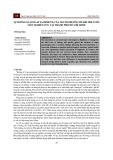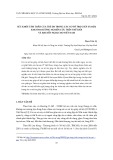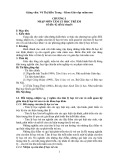
ISSN 1859-1531 - THE UNIVERSITY OF DANANG - JOURNAL OF SCIENCE AND TECHNOLOGY, VOL. 22, NO. 11C, 2024 83
PUBLIC PRESCHOOL ARCHITECTURE IN HO CHI MINH CITY -
ASSESSING THE CURRENT SITUATION TOWARDS THE DEVELOPMENT OF
CHILDREN'S EMOTIONAL INTELLIGENCE
Tan-Hanh Le*, Hanh Vu Thi Hong
University of Architecture Ho Chi Minh City, Vietnam
*Corresponding author: hanh.letan@uah.edu.vn
(Received: September 08, 2024; Revised: October 26, 2024; Accepted: October 13, 2024)
DOI: 10.31130/ud-jst.2024.563E
Abstract - In preschool education, not only teaching methods but
also the play-learning spaces play a crucial role in the holistic
development of children. A good learning environment should
not only focus on providing knowledge but also helps children
develop emotional and social skills. Emotional Intelligence (EI)
plays a key role in the development of these skills and needs to
be integrated into the architectural design of preschools. Using
the method of document analysis and actual survey, this paper
focuses on analyzing the role of Emotional Intelligence in the
design and construction of public preschools in Ho Chi Minh
City. It also assesses the current status of existing architectural
works and proposes design orientations aimed at optimizing play-
learning spaces for children.
Key words - Emotional Intelligence; preschool children; preschool
education; public preschool architecture; Ho Chi Minh City
1. Research question
In recent years, the development of preschool education
has become one of the top priorities in Ho Chi Minh City,
where the child population is growing rapidly along with
the urbanization process. Preschool is not only a place that
provides basic knowledge and skills but also an important
environment that helps children form emotional and social
values. In this context, emotional intelligence (EI) plays an
extremely important role in the comprehensive cognitive,
intellectual, physical, aesthetic and social-emotional
development of children.
Considering the scope of research on the architecture of
public preschools in the city, in Ho Chi Minh City today,
the general situation still has many limitations in creating a
learning and play environment that meets the needs of
children's emotional intelligence development. Most
preschool buildings have not been designed with careful
consideration of the impact of physical space on children's
emotions and behavior. Factors such as a lack of green
space, natural light and unscientific layout of play-learning
spaces can negatively affect the development of children's
emotional intelligence.
Emotional intelligence helps children recognize,
understand and manage personal emotions and social
interactions. Therefore, school architecture needs to be
designed to facilitate children's development of these
important skills. Elements such as color, lighting, materials
and spaces need to support children's mental and emotional
development. Building a friendly and emotionally
stimulating learning environment not only improves the
quality of education but also creates conditions for the
comprehensive development of children from the
preschool stage.
In this article, we will focus on analyzing the role of
emotional intelligence in preschool children from the
perspective of the current state of architectural space of
public preschools in Ho Chi Minh City, thereby orienting
a number of solutions to improve architectural design to
create an optimal play-learning and emotional
development environment for children.
2. Concept of Emotional Intelligence and preschool
education
2.1. Definition of Emotional Intelligence
Emotional intelligence is the ability to recognize,
understand and manage one's own emotions as well as
those of others. For children, emotional intelligence is one
of the fundamental factors that help children develop social
skills, adaptability and learning.
According to Yale University psychologist Peter
Salovey, today's definition of emotional intelligence can be
expanded and assessed in five main areas:
Figure 1. Key areas in the science of emotional intelligence -
Source: [3]
• Self-awareness: Accurately recognize emotions and
thoughts, evaluate strengths and weaknesses, have
confidence and optimism.
• Self-control: Manage emotions, thoughts, and
behaviors, control stress and impulses, and motivate
yourself.
• Social awareness: Empathize, understand social
norms, recognize sources of support from family and
community.
• Relationship management skills: Establish and
maintain healthy relationships, effective communication,

84 Tan-Hanh Le, Hanh Vu Thi Hong
cooperation, and conflict resolution.
• Make responsible decisions: Choose appropriate
behavior, considering ethical standards, safety, and
benefits for yourself and society.
2.2. The role of emotional intelligence in preschool
education development
In the current preschool education context, developing
children's emotional intelligence contributes to building a
positive learning environment, where children not only
develop intellectually but also emotionally. This helps
children have a solid foundation for comprehensive
development in the future [5], [6]:
● Developing social skills: Emotional intelligence
helps children improve communication, cooperation, and
interaction with others. Children easily understand and
respond to emotions, building positive relationships with
friends and adults.
● Enhance the ability to self-manage emotions: At
preschool age, children do not have good control over their
emotions. Emotional intelligence helps children identify
and regulate negative emotions such as anger or anxiety,
thereby responding more appropriately in situations.
● Improve learning ability: The ability to control
emotions helps children focus more in learning, manage
stress and be confident when participating in activities,
improving academic performance.
● Develop confidence and ability to face challenges:
Children with high emotional intelligence are often more
confident when solving problems and adapting to learning
and social environments, helping to develop perseverance
in the face of difficulties.
● Encourage empathy and understanding of others'
emotions: Emotional intelligence helps children
understand and share emotions with others, develop
empathy and understanding, and build a compassionate
social environment.
● Support building a moral foundation and life
values: Emotional intelligence not only helps regulate
emotions but also promotes values such as compassion,
respect, and social responsibility.
3. The relationship between preschool architectural
design and children's emotional intelligence
3.1. Architectural elements of preschools affect
children's emotions and behavior
● Architectural works: The layout of building blocks
greatly affects the operation of architectural spaces. The
distance and size of the building determine the connection
between spaces. The building and play spaces must be
arranged in harmony to have connection with each other to
ensure the normal operation of functions. The proportions
of the building's shapes must be beautiful and reasonable,
contributing to increasing the overall aesthetics. The
building's architecture must be suitable for preschool age
groups. Funny and cheerful images will have a good impact
on children, creating an attraction and desire for children
to go to school.
● Decoration, materials, colors and lighting:
Decorations, materials, colors and lighting play an important
role in organizing the architectural play-learning space for
children. Materials must be lively according to each space,
especially ensuring safety for children when playing. Light
must be enough to provide the interior spaces and colors help
reflect light, creating aesthetic effects that are beneficial for
children's visual development.
● Trees - water surface - small architecture: Trees in
the garden provide shade, repel insects, create fragrance
and produce beautiful flowers. Trees also contribute to
increasing the overall aesthetic of the project. Grass in the
garden or in each area not only has the effect of creating
scenery but also cleaning and avoiding dust for the project.
Small structures (rest huts, sculptures, etc.) will contribute
to increasing the quality of the play space. Water surfaces,
fountains, and small lakes will create cool air, while also
increasing aesthetics, creating a beautiful scene.
● Equipment and toys: Equipment in preschools must
be highly safe, synchronous, neat and convenient for
children to play and study, and must be suitable for the
characteristics of each age group. At the same time, the
equipment is not complicated for easy monitoring of care
and cleaning. Toys and other equipment used for children
must be beautiful in shape, balanced, and unique to help
with aesthetic education.
Figure 2. Architectural elements of preschools influenced by
Emotional Intelligence - Source: [4]
3.2. The impact of Emotional Intelligence on preschool
architecture
Emotional intelligence has a profound impact on
preschool architecture because it influences how spaces are
designed to support children's emotional, psychological
and social development, to name a few impacts. after:
● Create an environment that fosters positive
emotions: Preschool design needs to focus on creating a
safe, comfortable, and friendly space so that children feel
confident and secure when learning and playing. This
space helps children develop emotional intelligence,
encouraging curiosity and natural learning ability.

ISSN 1859-1531 - THE UNIVERSITY OF DANANG - JOURNAL OF SCIENCE AND TECHNOLOGY, VOL. 22, NO. 11C, 2024 85
● Encourage confidence and independence: Children
will develop confidence and independence when they are able
to take charge of their activities. The design of the preschool
space needs to be appropriate to the size and ability of the
child, such as suitable tables and chairs, and easy-to-access
functional areas. This encourages children to participate in
activities actively, thereby developing confidence.
● Active and creative learning space: Architecture
needs to create flexible, open spaces that stimulate
children's imagination and creativity. These spaces allow
children to freely explore, express themselves and thereby
develop creative thinking abilities as well as emotional
intelligence.
● Enhance communication and social interaction:
An important part of emotional intelligence is the ability to
communicate and interact socially. Preschool architecture
needs to design areas that encourage children to
communicate and work in groups, such as group learning
spaces and common play areas, helping children develop
skills in working with friends and learn to cooperate.
● Child-centered design: In architectural design,
careful consideration should be given to children's
emotional needs. Using soft colors, natural light and
natural elements such as trees and gardens will help
children feel safe, peaceful and relaxed.
● Sound control and quiet environment: Sound plays
an important role in the learning environment. An
environment that is too noisy can distract and stress
children. Therefore, it is necessary to have soundproofing
measures and create quiet spaces to help children easily
concentrate and develop emotionally.
● Develop emotional management skills: Relaxing,
quiet areas such as reading corners or natural spaces help
children learn to recognize and manage their emotions
when stressed or tired, thereby developing the ability to
effectively regulate emotions.
● Encourage empathy and connection: Shared play
and learning spaces help children develop empathy skills,
learn to understand and share with friends. When children
feel connected and belong to a community, they learn to
respect the feelings of others and develop greater emotional
intelligence.
● The impact of connection to nature: Preschool
architecture can take advantage of natural elements such as
green areas and gardens to help children connect with
nature. Nature not only helps children relax and reduce
stress, but also creates conditions for children to develop
emotional intelligence and interact more positively.
● Multifunctional space for comprehensive
development: Preschools need to provide diverse spaces such
as learning areas, play areas, sports areas, and art spaces.
These spaces help children develop comprehensively
emotionally, physically and socially, promoting the
development of comprehensive emotional intelligence.
4. Current status of public preschool architecture in Ho
Chi Minh city
As a strongly developed and largest city in the country
in almost every aspect, Ho Chi Minh City has been facing
many challenges in education management and
development, especially in preschool education; This is
clearly shown in the comments about the current state of
the organization of architectural spaces in the vast majority
of public preschools today.
● Total area
- According to the report of the City Department of
Construction. Ho Chi Minh City, by 2023, the city has
more than 1,300 preschools, of which about 60% are public
schools. However, only 30% of schools meet the standards
for space and facilities according to regulations of the
Ministry of Education and Training. Accordingly, the land
area for preschool construction averages 8-10 m²/child,
lower than the national standard of 12-15 m²/child [1], [2].
- Currently, many public preschools in Ho Chi Minh
city faces difficulties in land size and area, especially in
central districts, due to land scarcity and rapid
urbanization. The overall planning is patchy, without a
unified whole due to inconsistent investment and not
suitable for the development needs of the industry. The
area of schools is often small, with no space or reserve land
fund for development.
- Public preschools in suburban areas often have larger
premises, but due to their distance from the center and
sparse population density, the occupancy rate is not high,
causing waste of resources.
● Architectural form
- Many old public preschools in Ho Chi Minh City were
built before 2000, having simple architecture, with concrete
structure, reinforced steel and tile or corrugated iron roof.
Classrooms are arranged in the form of adjacent classrooms,
with little green space or large playgrounds. A typical
example is 19/5 Kindergarten in District 1, built in the 1990s
with a 1-2 storey design and corridors connecting classes.
Figure 3. Kindergarten 19.5, District 1 - Source: [4]
- Preschools built after 2010 have had a clear change in
architectural form, with open space design, many outdoor
play areas, making the most of natural light. A specific
example is Saigon South Kindergarten (District 7). This is
one of the advanced public preschools built according to
international standards. The total school area is 8,000 m²,
with blocks arranged in an open format, including study
areas, play areas, gardens and swimming pools. The school
uses green materials such as wood, glass, and trees
throughout the campus, helping to reduce internal
temperatures. Learning spaces are arranged flexibly, with
classrooms with outside views and optimal natural light.
This school is highly appreciated for creating a friendly
environment that contributes to children's emotional
development.

86 Tan-Hanh Le, Hanh Vu Thi Hong
Figure 4. Saigon South Kindergarten, District 7 - Source: [4]
● Decoration, materials, colors, lighting
According to Ho Chi Minh City Department of
Education (2023), 40% of public preschools have been
renovated or newly built, while 60% of schools still use old
materials and lighting systems [1], [2].
- Decoration: Most public preschools in the city. HCM
uses vivid images, paintings and educational symbols on
the walls. However, some old schools have simple, less
creative decorations such as 19/5 Kindergarten, Ben Nghe
(District 1).
- Materials: Old schools often use concrete, bricks and
industrial wood, while new schools use more friendly
materials such as glass and natural wood. Hoa Mai
Kindergarten (Binh Thanh District) is an example of
applying modern and sustainable materials.
- Color: New schools often use bright colors (green,
yellow) to stimulate children's creativity. Meanwhile, old
schools such as Son Ca Kindergarten (Tan Binh District)
use monotonous colors, not optimized for children's
emotional development.
- Lighting: New schools make good use of natural light
with many large windows, such as Saigon South
Kindergarten (District 7), while many old schools rely on
artificial light from fluorescent lights, such as Kindergarten
Hoa Hong mountain (District 3).
Figure 5. Ben Thanh Kindergarten, District 1 - Source: [4]
● Green trees, water surface, small architecture
According to a report by the Ho Chi Minh City
Department of Education (2023), 70% of schools have
green spaces, 30% of schools have water surfaces, and 50%
of schools have small structures for children. Green
landscape elements, interior and exterior decoration, and
small architecture are often omitted because they are
considered wasteful and not a priority. Or sometimes it is
not taken care of and is not suitable for the school's
common space [1], [2].
- Trees: about 70% of public preschools have green
spaces, mainly decorative and shade trees. For example:
An Binh Kindergarten (District 2) with a rich green garden
helps children develop positive emotions.
- Water surface: Only 30% of schools have swimming
pools or water areas. For example: Be Ngoan Kindergarten
(District 1), Binh Minh (District 7) has a mini swimming
pool, creating opportunities for children to learn about the
water environment.
- Small architecture: About 50% of schools lack small
architecture such as huts and outdoor play areas. For
example, Hoa Huong Duong Kindergarten (District 8) has
built a hut and a safe play area for children.
Figure 6. Be Ngoan Kindergarten, District 1 - Source: [4]
● Equipment, games
- Equipment: According to a survey by the Ho Chi
Minh City Department of Education (2023), about 60% of
public preschools lack modern equipment for teaching and
learning. Many schools still use old equipment that does
not meet teaching requirements. Teaching equipment such
as projectors and interactive whiteboards are only available
in about 40% of schools [1], [2]. For example: Thanh Da
Kindergarten (Binh Thanh) has old school equipment and
supplies, affecting the quality of education.
- Games: Only about 50% of schools have outdoor play
areas large and safe enough for children [1], [2]. The
number of outdoor and classroom toys is limited, mainly
traditional wooden toys. There is too little individual or
small group space or toys that stimulate children's
comprehensive development, and they are not flexible
enough for different ages of children. This may partly lead
to a lack of exercise and thinking in children. For example,
Bong Sen Kindergarten (District 10) was invested by a
modern outdoor play area with equipment such as slides
and swings, helping children develop physically and
mentally.
- The outdoor playground area is often small and is
arranged in the central front yard or taking advantage of the
circulation corridor in front of the classroom to make part
of the playground for children. This area cannot be
guaranteed to meet standards (2.5m2/child).
Figure 7. Childhood Preschool 7, District 3 - Source: [4]
Thus, limitations in funding, area and professional
knowledge of child psychology, etc. are major barriers in
applying emotional intelligence to preschool architecture.
The general situation is that play-learning spaces are often
narrow and do not take full advantage of natural elements.
Other elements, such as trees, decorations, recreational

ISSN 1859-1531 - THE UNIVERSITY OF DANANG - JOURNAL OF SCIENCE AND TECHNOLOGY, VOL. 22, NO. 11C, 2024 87
activities, and group gatherings, simply adhere to the
guidelines set for the cramped area above. Currently,
school architectural projects often focus on functional
factors rather than children's emotional development.
Integrating emotional intelligence into preschool planning
and architecture has not yet received attention.
5. Analysis of some preschool architectural models
designed based on Emotional Intelligence
Preschool architectural models based on emotional
intelligence not only focus on creating a friendly play-
learning environment but also help children develop
comprehensively emotionally, socially and cognitively.
Investing in appropriate architectural design will improve
the quality of preschool education and support children's
comprehensive development.
Kindergarten model according to Montessori
educational philosophy: This model focuses on creating
flexible play-learning spaces where children can freely
move and choose activities. The school's architecture often
uses gentle colors, natural light and open learning areas,
helping children feel comfortable and safe. The design of
outdoor activity areas also encourages children to interact
with nature, develop emotions and creativity.
Some typical Montessori Preschools in Ho Chi Minh
City: Montessori Worldkids – WIS, WonderKids
Montessori School – WMS, Tiny Flower Montessori
School, The Montessori International School of Vietnam,
Wonderkids Montessori, Saigon Montessori,… have been
designed with open learning spaces and playgrounds
combined with trees, helping children explore and develop
emotional intelligence.
Kindergarten model according to Reggio Emilia
educational philosophy: This model emphasizes designing
learning spaces that reflect children's needs and interests.
The architecture is built from natural materials, helping
children connect with their surroundings. Activity areas are
scientifically arranged to encourage communication and
cooperation between children, thereby developing social
skills and emotional intelligence.
Little Em's Sun World preschool system (District 3, Ho
Chi Minh City) was designed with many creative spaces,
such as art corners and outdoor play areas, to help children
develop empathy and abilities for group work.
Green School kindergarten model: The model focuses
on integrating nature into the learning environment. The
school's architecture uses environmentally friendly
materials and open space design, encouraging children to
explore nature and develop emotional sensitivity. Children
are encouraged to participate in outdoor activities, which
help increase self-confidence and empathy.
The Green School Kindergarten system is currently
developing widely throughout a number of Northern
provinces. Focused mainly in Hanoi City with 5
facilities,... with gardens and spacious outdoor learning
areas, creating conditions for children to develop both
physically and emotionally.
6. Some directions in applying Emotional Intelligence
to the architectural design of public preschools in Ho
Chi Minh city
Applying emotional intelligence to preschool
architectural design can create learning and living spaces
suitable to children's emotional and psychological
development needs. Based on the following main research
framework, the author has proposed important design
directions to integrate emotional intelligence into
preschool architecture:
Figure 8. Main research framework of the article
Source: author, [1], [7]
6.1. Flexible space, stimulating creativity
Design flexible play-learning areas that can be changed
to serve many different activities, giving children the
opportunity to explore, interact and develop creative
thinking. For example, classrooms can be arranged to
transition between group activities, individual activities, or
free play, to encourage children to express themselves in a
variety of ways.
6.2. Use colors that create positive emotions
Colors have a strong impact on children's emotions.
Bright, gentle colors such as green, light yellow or blue can
create a comfortable space, encouraging children to play
and study. On the contrary, colors that are too bold or too
bright can be irritating or distracting.
6.3. Natural space and natural light
Connecting indoor and outdoor spaces through small
gardens, playgrounds or open areas with natural light helps
children feel close to nature. This can reduce stress and
anxiety and promote calmness, helping children develop
positive emotions and a sense of security.

![Câu hỏi ôn thi Tâm lý trẻ em [năm hiện tại] chuẩn nhất](https://cdn.tailieu.vn/images/document/thumbnail/2025/20250703/kimphuong1001/135x160/2901751517904.jpg)





![Đề cương tâm lý học lứa tuổi và sư phạm tiểu học [chuẩn nhất]](https://cdn.tailieu.vn/images/document/thumbnail/2015/20151003/ohmyghost1505/135x160/513167990.jpg)





![Câu hỏi ôn tập Tâm lý học quản lý [chuẩn nhất]](https://cdn.tailieu.vn/images/document/thumbnail/2025/20251125/hathunguyen04er@gmail.com/135x160/25191764124376.jpg)
![Cẩm nang chăm sóc và nuôi dạy trẻ tăng động giảm chú ý [chuẩn nhất]](https://cdn.tailieu.vn/images/document/thumbnail/2025/20251118/kimphuong1001/135x160/4241763431998.jpg)


![Sổ tay Hướng dẫn tự chăm sóc trầm cảm [chuẩn nhất]](https://cdn.tailieu.vn/images/document/thumbnail/2025/20251029/kimphuong1001/135x160/3711761720335.jpg)
![Đề cương Tâm lý học xã hội [chuẩn nhất]](https://cdn.tailieu.vn/images/document/thumbnail/2025/20251028/c.dat0606@gmail.com/135x160/99271761707421.jpg)
![Câu hỏi ôn thi Nhập môn khoa học nhận thức [chuẩn nhất]](https://cdn.tailieu.vn/images/document/thumbnail/2025/20251021/aduc03712@gmail.com/135x160/48471761019872.jpg)

![Đề cương môn Tâm lý học sinh tiểu học [chuẩn nhất]](https://cdn.tailieu.vn/images/document/thumbnail/2025/20251007/kimphuong1001/135x160/51781759830425.jpg)



![Tâm lí học lứa tuổi và sư phạm ở tiểu học: Bài thuyết trình [chuẩn nhất]](https://cdn.tailieu.vn/images/document/thumbnail/2025/20250918/vuhoaithuong14@gmail.com/135x160/90941758161117.jpg)
